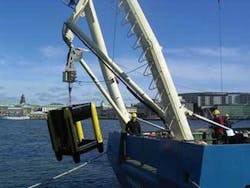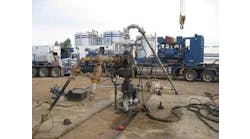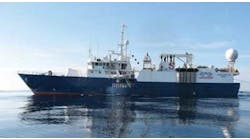In September, Marin Mätteknik (MMT) began a survey of possible routes for subsea pipelines carrying carbon dioxide to storage sites in the Norwegian offshore sector. The work was expected to take about a month to complete, according to contract manager Olof Nilsson.
The survey was commissioned by Gassco, the state-owned company which operates much of Norway’s gas pipeline network, in conjunction with Gassnova SF and the Norwegian Petroleum Directorate.
Deployment of the remotely operated towfish vehicle that MMT has used in recent projects from the stern of theFranklin survey vessel.
As part of the government’s drive to tackle Norway’s CO2 emissions, the three companies are evaluating technical solutions for the transport of CO2 captured from the flue gas at two facilities Naturkraft’s 420 MW gas-fired power plant at the Kårstø gas terminal, and the combined heating and power plant at StatoilHydro’s Mongstad refinery due to start up in 2010. Both are located close together on the coast of western Norway.
The MMT survey covers a total of 636 km (395 mi) of seabed out to potential disposal sites such as the Sleipner field, where StatoilHydro already stores CO2 extracted from produced natural gas. The work will provide essential data for the transport routes which will be further developed in a pre-engineering phase due to start in the first quarter of 2009, Gassco says.
From its survey vesselFranklin, MMT deployed a side-scan sonar to perform an acoustic seabed survey, a sub-bottom profiler to examine the soils beneath the seafloor, and a multibeam echo sounder to create a 3D image of the seafloor.
For the acoustic mapping, MMT used its remote operated towfish vehicle (ROTV). This is a MacArtney Focus-2 vehicle that the company acquired earlier this year for a pipeline inspection for Dong in the Danish sector, but which has proved so useful that it has been employed in all MMT’s subsequent projects.
The vehicle, towed behind the survey vessel, is programmed to steer a pre-determined course while maintaining a constant height above the seabed. Compared with a conventional ROV or towfish, the ROTV enables surveys to be performed faster and more precise data to be acquired, says Nilsson.
Earlier this year, MMT completed another assignment for Gassco, surveying routes for the proposed Skanled gas pipeline from western Norway to Sweden and Denmark. This work, the first part of which was conducted last year, involved acoustic seabed mapping, seabed sampling and ROV inspection. MMT worked with Swedish archeologists to identify sites of shipwrecks which the route would need to avoid.
For more information contact Olof Nilsson, Marin Mätteknik. Tel +46 31 69 5280, fax +46 31 69 5290,[email protected], www.mmtab.se




